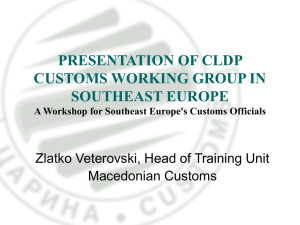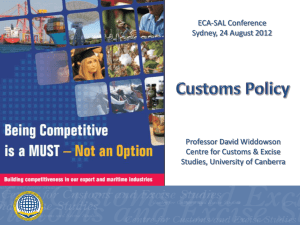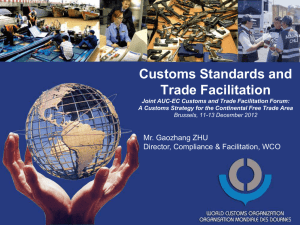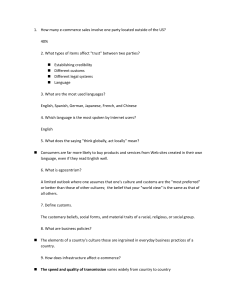Requirements of an aeo programme
advertisement
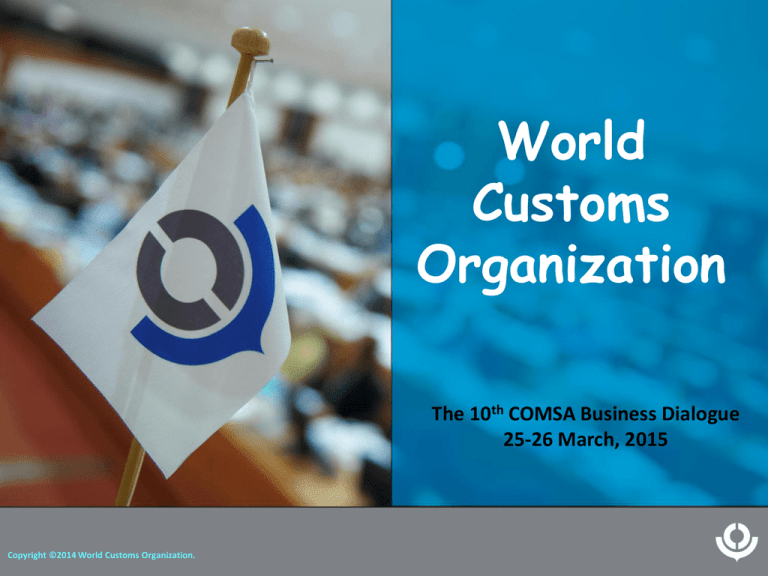
World Customs Organization The 10th COMSA Business Dialogue 25-26 March, 2015 Copyright ©2014 World Customs Organization. Outline The WCO o Introduction Illicit trade o key areas & challenges WCO Instruments & Tools o Partnership approach Inter-agency Cooperation o o Coordinated Border Management (CBM) Potential opportunities © World Customs Organization Strategic Plan © World Customs Organization WCO focus on key areas of Illicit trade REVENUE SECURITY HEALTH & SAFETY AND IPR DRUGS ENFORCEMENT CEN & RM/Intelligence Programmes WCO Illicit Trade Report 2013 - analysis of trends and patters in these five key risk areas ENVIRONMENT Common Challenges Illicit trade and cross-border smuggling Evasion of taxes and duties Trade mispricing Illicit financial flows Money laundering Informal Trade Common goal of securing government revenues and combating illicit activities and facilitating compliant business! Needs Whole Government Approach. © World Customs Organization Fostering Partnerships Customs – Customs Customs – Business Customs – other Government agencies Bilateral, Plurilateral and Multilateral Cooperation © World Customs Organization Customs – Customs Cooperation WCO Instruments and Tools Nairobi Convention o In force since May 1980 - 52 Contracting Parties Johannesburg Convention (not in force) o Adopted in 2003 - 3 Contracting Parties - not in force Revised Kyoto Convention o In force since 2006 - 97 Contracting Parties SAFE Framework of Standards o Adopted in 2005 – Letter of Intent by 168 Members Cyprus Declaration 2000 Various WCO Recommendations © World Customs Organization Customs – Customs Cooperation Model Bilateral Agreement on Mutual Administrative Assistance in Customs Matters o Developed in 2004 o Extensively used by Members for bilateral agreements Globally Networked Customs (GNC) o Set of Protocols, Guidelines and Standards for exchange of information o Feasibility Study Report 2012 o Proof of Concept stage – 5 UBs (Including the Exchange of information project between South Africa and Swaziland) Customs Enforcement Network (CEN) o A system to share and disseminate information on Customs offences in a timely, reliable and secure manner o Over 1700 users from 145 countries National Customs Enforcement Network (nCEN) o National nominal seizure database o Pilots (Mauritius, Kenya) completed © World Customs Organization Customs - Business Customs – Business Partnership o o SAFE AEO programmes WCO Customs-Business Partnership Guidance Leveraging Trade Intelligence Data Quality Capacity Building © World Customs Organization Customs – Other Government Agencies WCO Instruments & Tools: Coordinated Border Management o WCO Coordinated Management Compendium o A Whole Government Approach WCO theme for 2015 “Coordinated Border Management - An inclusive approach for connecting stakeholders”. Pillar 3 in the SAFE 2015 edition © World Customs Organization CBM: Concepts & Applications Shared Information Shared Resource • Eliminates duplications in info requirements – each information only needs to be submitted once • Allows all personnel have the info they need to do their work effectively • Reduces costs through sharing resources between different agencies – NII equipment, inspection bays, offices, IT systems • Co-location allows everyone to work “under one roof”, enhancing communication and availability Shared Work • Agencies empowered to assist each other. E.g. customs empowered to conduct checks on behalf of CBRAs, in a joint border post, customs from either country can clear imports / exports Shared Responsibilities • Common sense of purpose and vision among all agencies at the border. • Facilitation coordinated between all agencies, controls determined holistically Cooperation in Action at International level UNODC-WCO Container Control Programme o o aimed to improve their law enforcement capacity, thereby preventing drug trafficking and other illegal activity, while also facilitating legitimate trade. the Port Control Units representing staff from different border enforcement agencies Project Aircop o a joint UNODC-WCO-INTERPOL endeavor in combating against trafficking of cocaine and other illegal drugs by air from South America via West Africa to Europe. Programme Global Shield o aimed at combating illicit diversion and trafficking of explosive precursor chemicals used to manufacture improvised explosive devices. Other Joint Operations/Projects: GRYPHON, Cocair, Gapin, Crocodile, Westerlies,Cullimen, Demeter, Cobra, Short-Circuit © World Customs Organization Eastern and South Africa - Regional perspective in illicit trade IPR infringements (all region) Tobacco (Southern Africa) Wildlife ( East Africa) © World Customs Organization WCO activities in the Region Wildlife illicit trade: The WCO operation under the framework of the Great Apes and Integrity project in January/February 2011 (2 weeks) Aiming to raise awareness and build the enforcement and integrity capacity of some customs administrations in the ESA in the implementation of the CITES Convention, in particular the combating of illicit trafficking in great apes ( Chimpazes, Gorillas and Baboons) and other protected species. Tobacco illicit trade: The WCO supporting countries in region in fighting tobacco Illicit trade with ‘Operation GRYPHON’ (6 months starting in October 2013) Focused on the application of core Customs legislation, competencies across the entire Customs control and clearance process including checks being conducted on duty free outlets, free zones, stores, bonded warehouses and means of transport Counterfeit goods: The WCO recommended all ESA countries to comply with the TRIPS agreement and provide a robust enabling IPR legislation The WCO has been supporting the ESA countries with various capacity building missions to empower members in the fight of IPR infringements. © World Customs Organization CONTACTS Christine F. Msemburi Director World Customs Organization East & Southern Africa Regional Office for Capacity Building, Forodha House 3rd Floor 3 Upper Hill Close P. O. Box 50581- 00200 NAIROB, KENYA. Tel +254 20 27 37 444 / Fax +254 20 27 37 968 Email: christine.msemburi@wcoesarocb.org rocb@wcoesarocb.org www.wcoesarocb.org 15
